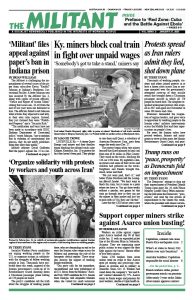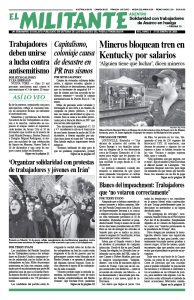Thousands of working people, students and others joined protests in at least a dozen cities across Iran as outrage mounted over the government’s attempted cover-up of their missile attack that brought down a Ukrainian passenger aircraft in which all 176 people on board died. The slaughter reignited widespread protests that erupted in 2017 and again last November in some 100 towns and cities.
Protesters demanded the resignation of regime leaders, and gave voice to opposition by working people to the Iranian rulers’ military interventions across the Middle East and their repercussions on people’s lives.
For years the Iranian rulers have pressed workers, farmers and immigrants to serve in their army, the Islamic Revolutionary Guard Corps, and paramilitary forces they organize, seeking to extend their sway through intervention in the conflicts taking place in Iraq, Syria, Lebanon and elsewhere. The deadly and destructive consequences of these wars falls overwhelmingly on the working class.
For three days the government lied about the Revolutionary Guard’s shooting down of the Ukrainian International Airlines Boeing aircraft after it took off from Tehran bound for Kyiv and then Canada Jan. 8. Officials denied responsibility, insisting the flight had suffered mechanical problems. Lost in the missile attack were 82 Iranians and 63 Canadians, many students studying abroad or holding joint citizenship.
Protests began at Amir Kabir University in Tehran at a vigil organized for 16 students killed in the missile strike. Actions spread to other colleges there, to Tehran’s Azadi Square and to Esfahan, Rasht, Yazd, Kerman, Shiraz, Hamedan, Boroujerd and other cities.
Protesters demand ousting of gov’t
Protesters in Tehran chanted, “Death to liars” and “Death to the dictator,” referring to Supreme Leader Ali Khamenei. They demanded the Iranian Revolutionary Guard — a central pillar of the regime’s rule at home and whose Quds Force has led its intervention abroad — “let go of the country.” The Quds Force was formerly led by Gen. Qassem Soleimani, who was killed in a U.S. military drone strike Jan. 2.
Others chanted, “The game is over” for both “reformists” and “principlists” — popular names for the two wings of the bourgeois clerical regime that have ruled the country since leading a counterrevolution in the early 1980s. The regime pushed back gains won by working people in the 1979 Iranian Revolution that overthrew the U.S.-backed rule of the shah, established workers councils — called shoras — in factories and oil refineries across the country, and fueled struggles by farmers, oppressed nationalities and women.
The anti-government protests came just days after authorities claimed the country had been unified behind the regime during funeral processions for Soleimani, and then showed their disdain for ordinary people when they did nothing to prevent more than 50 mourners from getting killed in a stampede.
After evidence was posted to social media from videos taken by people who saw the plane plummet after being hit, the regime refused to allow Boeing, the Ukrainians or anyone else to get access to the plane’s black boxes. Then there were photos of what appeared to be efforts by the government to steamroll away the remains of the plane’s wreckage.
More video that surfaced Jan. 14 confirmed U.S. officials’ claims that the Revolutionary Guard fired not one but two missiles to down the plane.
Finally Iranian officials admitted they had “accidentally” shot the plane down, confusing it with a guided missile. Major Gen. Hossein Salami, the most senior commander of the Revolutionary Guard, issued a public apology and was summoned to a closed session of parliament Jan. 12.
“Why insist on lying for a few days?” asked Gholamreza Haydari, a member of parliament from Tehran. “We need to go after the highest chain of command responsible for this.”
A few other members of parliament also spoke out against the moral bankruptcy of the cover-up. In an effort to mollify the growing protests and pin blame on rivals in the regime, President Hassan Rouhani urged the courts to arrest and punish those responsible for downing the plane.
Some protesters in Tehran denounced Soleimani, who had helped organize the Iranian capitalist rulers’ military forces that crushed the anti-government protests in November, when at least 300 people were killed and over 1,000 arrested.
In Mahshahr, a largely Arab cities in the country’s southwest, Revolutionary Guard forces surrounded and gunned down fleeing protesters in a marsh where they sought refuge during the November protests.
Washington out now!
But none of Tehran’s counterrevolutionary actions at home or in the region excuse the U.S. imperialist intervention in Iraq and across the Middle East. Seeking to use the weight of their massive military machine to deter further attacks from Tehran, the U.S. rulers have increased their ground, naval and air forces in the region to over 80,000 troops.
And they’ve continued to tighten stifling sanctions that fall most sharply on Iran’s working people. President Donald Trump announced further punitive measures Jan. 10, including sanctions on Iran’s trade in metals, construction, manufacturing, textiles and mining. The governments of France, Germany and the U.K. took the first steps to reimpose sanctions on Iran Jan. 14, saying Tehran had violated the 2015 nuclear pact that Washington pulled out of in 2018.
“The Socialist Workers Party calls for the immediate, unconditional and total withdrawal of all U.S. troops, bases, weaponry and armaments from Iraq, Syria and the region,” Naomi Craine, SWP candidate for U.S. Senate from Illinois, said in a statement Jan. 10 available on the Militant’s website. “U.S. hands off Iran!”
New waves of anti-government protests have also broken out in Iraq, with thousands in the streets Jan. 10. The protests are fueled by a lack of political rights, jobs and basic services, and widespread anger at the deadly impact of Tehran’s intervention in the country.
“We have all seen and felt what this government has done,” Ahmed al-Rikabi told Al Jazeera in Baghdad’s Tahrir Square. “They have done it with Iranian help, they did it with Qassem Soleimani too.” At least 500 people have been killed by pro-government forces and Tehran-organized militias attempting to drive fear into the workers and young people who’ve been in the streets since October.

